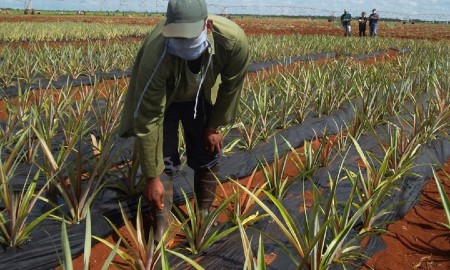HAVANA, Cuba – Officials within Cuba’s agriculture industry have stated that studies being carried out on plantations in central Cuba with certain varieties of pineapple, known as the Champaka-153, Perola, Española Roja and MD-2 varieties, have shown encouraging results in terms of their production, resistance to diseases and fruit weight.
 Photo courtesy of Cuba's Ministry of AgricultureThe experiments are part of the integrated project between the Bioplants Center, ascribed to the Maximo Gomez Baez University of that province and the producers of the Basic Business Unit (UEB by its Spanish acronym) Pineapple, of the Ceballos Agroindustrial Company, in charge of applying the science in function of the harvests.
Photo courtesy of Cuba's Ministry of AgricultureThe experiments are part of the integrated project between the Bioplants Center, ascribed to the Maximo Gomez Baez University of that province and the producers of the Basic Business Unit (UEB by its Spanish acronym) Pineapple, of the Ceballos Agroindustrial Company, in charge of applying the science in function of the harvests.
Romelio Rodriguez Sanchez, technology, science and innovation specialist at UEB Pineapple, recalled that this fruit, depending on the variety, takes between 14 and 16 months to be tasted and requires ideal conditions to express its genetic potential.
This is the third year that the morpho-physiological behavior of the Champaka-153 variety is being evaluated in farm conditions, of which three hectares were occupied in 2022 with the agamic offspring achieved in 2020 in one hectare.
According to Sanchez, the fruit that only suffered variation in the crown, weighs more than two kilograms, is sweet, white, resistant to soil fungi and is ideal for cutting and slicing in the industry.
The Perola is in its second year of study and has also proven to be very good for consumption by the population and for industrial purposes, specifically in the production of juices and slices.
“Like Champaka-153, it achieves a high survival rate, which helps to improve yields, as both varieties are between 45 and 60 tons per hectare depending on the planting frame, which in the case of the experiment is 45,000 agamic shoots.”
“Currently, another 15,000 vitroplants are being planted in half a hectare more, because what we are looking for is to rejuvenate the seed of this variety and at the same time give it more strength,” Sanchez concluded.


